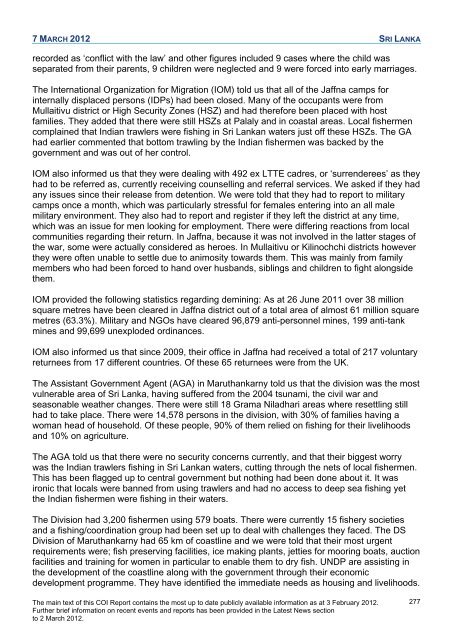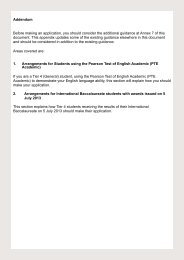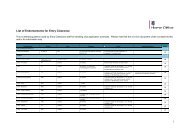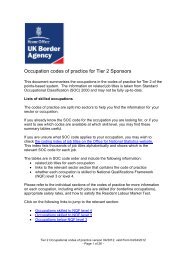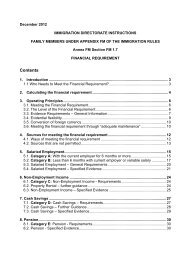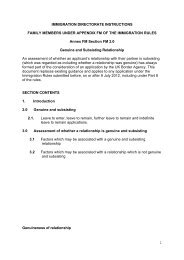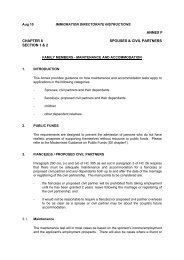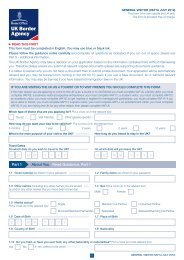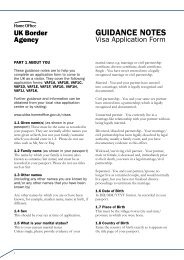COI Report March 2012 - UK Border Agency - Home Office
COI Report March 2012 - UK Border Agency - Home Office
COI Report March 2012 - UK Border Agency - Home Office
You also want an ePaper? Increase the reach of your titles
YUMPU automatically turns print PDFs into web optimized ePapers that Google loves.
7 MARCH <strong>2012</strong> SRI LANKA<br />
recorded as ‗conflict with the law‘ and other figures included 9 cases where the child was<br />
separated from their parents, 9 children were neglected and 9 were forced into early marriages.<br />
The International Organization for Migration (IOM) told us that all of the Jaffna camps for<br />
internally displaced persons (IDPs) had been closed. Many of the occupants were from<br />
Mullaitivu district or High Security Zones (HSZ) and had therefore been placed with host<br />
families. They added that there were still HSZs at Palaly and in coastal areas. Local fishermen<br />
complained that Indian trawlers were fishing in Sri Lankan waters just off these HSZs. The GA<br />
had earlier commented that bottom trawling by the Indian fishermen was backed by the<br />
government and was out of her control.<br />
IOM also informed us that they were dealing with 492 ex LTTE cadres, or ‗surrenderees‘ as they<br />
had to be referred as, currently receiving counselling and referral services. We asked if they had<br />
any issues since their release from detention. We were told that they had to report to military<br />
camps once a month, which was particularly stressful for females entering into an all male<br />
military environment. They also had to report and register if they left the district at any time,<br />
which was an issue for men looking for employment. There were differing reactions from local<br />
communities regarding their return. In Jaffna, because it was not involved in the latter stages of<br />
the war, some were actually considered as heroes. In Mullaitivu or Kilinochchi districts however<br />
they were often unable to settle due to animosity towards them. This was mainly from family<br />
members who had been forced to hand over husbands, siblings and children to fight alongside<br />
them.<br />
IOM provided the following statistics regarding demining: As at 26 June 2011 over 38 million<br />
square metres have been cleared in Jaffna district out of a total area of almost 61 million square<br />
metres (63.3%). Military and NGOs have cleared 96,879 anti-personnel mines, 199 anti-tank<br />
mines and 99,699 unexploded ordinances.<br />
IOM also informed us that since 2009, their office in Jaffna had received a total of 217 voluntary<br />
returnees from 17 different countries. Of these 65 returnees were from the <strong>UK</strong>.<br />
The Assistant Government Agent (AGA) in Maruthankarny told us that the division was the most<br />
vulnerable area of Sri Lanka, having suffered from the 2004 tsunami, the civil war and<br />
seasonable weather changes. There were still 18 Grama Niladhari areas where resettling still<br />
had to take place. There were 14,578 persons in the division, with 30% of families having a<br />
woman head of household. Of these people, 90% of them relied on fishing for their livelihoods<br />
and 10% on agriculture.<br />
The AGA told us that there were no security concerns currently, and that their biggest worry<br />
was the Indian trawlers fishing in Sri Lankan waters, cutting through the nets of local fishermen.<br />
This has been flagged up to central government but nothing had been done about it. It was<br />
ironic that locals were banned from using trawlers and had no access to deep sea fishing yet<br />
the Indian fishermen were fishing in their waters.<br />
The Division had 3,200 fishermen using 579 boats. There were currently 15 fishery societies<br />
and a fishing/coordination group had been set up to deal with challenges they faced. The DS<br />
Division of Maruthankarny had 65 km of coastline and we were told that their most urgent<br />
requirements were; fish preserving facilities, ice making plants, jetties for mooring boats, auction<br />
facilities and training for women in particular to enable them to dry fish. UNDP are assisting in<br />
the development of the coastline along with the government through their economic<br />
development programme. They have identified the immediate needs as housing and livelihoods.<br />
The main text of this <strong>COI</strong> <strong>Report</strong> contains the most up to date publicly available information as at 3 February <strong>2012</strong>.<br />
Further brief information on recent events and reports has been provided in the Latest News section<br />
to 2 <strong>March</strong> <strong>2012</strong>.<br />
277


